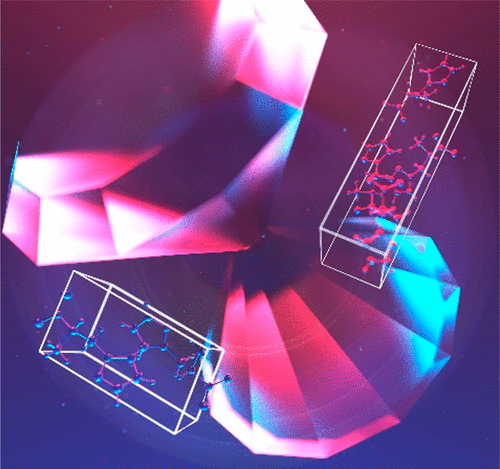当前位置:
X-MOL 学术
›
Cryst. Growth Des.
›
论文详情
Our official English website, www.x-mol.net, welcomes your feedback! (Note: you will need to create a separate account there.)
Effect of High Pressure on the Crystal Structures of Polymorphs of l-Histidine
Crystal Growth & Design ( IF 3.8 ) Pub Date : 2020-11-06 , DOI: 10.1021/acs.cgd.0c01085 Giulia Novelli 1 , Helen E. Maynard-Casely 2 , Garry J. McIntyre 2 , Mark R. Warren 3 , Simon Parsons 1
Crystal Growth & Design ( IF 3.8 ) Pub Date : 2020-11-06 , DOI: 10.1021/acs.cgd.0c01085 Giulia Novelli 1 , Helen E. Maynard-Casely 2 , Garry J. McIntyre 2 , Mark R. Warren 3 , Simon Parsons 1
Affiliation

|
The effect of pressure on the crystal structures of the two ambient-pressure polymorphs of the amino acid l-histidine has been investigated. Single-crystal diffraction measurements, up to 6.60 GPa for the orthorhombic form I (P212121) and 6.85 GPa for the monoclinic form II (P21), show their crystal structures undergo isosymmetric single-crystal-to-single-crystal first-order phase transitions at 4.5 and 3.1 GPa to forms I′ and II′, respectively. Although the similarity in crystal packing and intermolecular interaction energies between the polymorphs is remarkable at ambient conditions, the manner in which each polymorph responds to pressure is different. Form II is found to be more compressible than form I, with bulk moduli of 11.6(6) GPa and 14.0(5) GPa, respectively. The order of compressibility follows the densities of the polymorphs at ambient conditions (1.450 and 1.439 g cm–3 for phases I and II, respectively). The difference is also related to the space-group symmetry, the softer monoclinic form having more degrees of freedom available to accommodate the change in pressure. In the orthorhombic form, the imidazole-based hydrogen atom involved in the H-bond along the c-direction swaps the acceptor oxygen atom at the transition to phase I′; the same swap occurs just after the phase transition in the monoclinic form and is also preceded by a bifurcation. Concurrently, the H-bond and the long-range electrostatic interaction along the b-direction form a three-centered H-bond at the I to I′ transition, while they swap their character during the II to II′ transition. The structural data were interpreted using periodic-density-functional theory, symmetry-adapted perturbation theory, and semiempirical Pixel calculations, which indicate that the transition is driven by minimization of volume, the intermolecular interactions generally being destabilized by the phase transitions. Nevertheless, volume calculations are used to show that networks of intermolecular contacts in both phases are very much less compressible than the interstitial void spaces, having bulk moduli similar to moderately hard metals. The volumes of the networks actually expand over the course of both phase transitions, with the overall unit-cell-volume decrease occurring through larger compression of interstitial void space.
中文翻译:

高压对1-组氨酸多晶型物晶体结构的影响
已经研究了压力对氨基酸1-组氨酸的两个环境压力多晶型物的晶体结构的影响。单晶衍射测量,正交晶型I(P 2 1 2 1 2 1)高达6.60 GPa,单斜晶型II(P 2 1)高达6.85 GPa),表明它们的晶体结构分别在4.5 GPa和3.1 GPa下经历等对称单晶至单晶一阶相变,分别形成I'和II'。尽管在环境条件下多晶型物之间的晶体堆积和分子间相互作用能的相似性很显着,但是每种多晶型物对压力的响应方式却不同。发现形式II比形式I更具可压缩性,体积模量分别为11.6(6)GPa和14.0(5)GPa。在环境条件下(1.450和1.439 g cm –3),可压缩性的顺序遵循多晶型物的密度。分别用于第一阶段和第二阶段)。这种差异还与空间群的对称性有关,较软的单斜晶形式具有更多的自由度,可以适应压力的变化。在正交晶形式中,沿c方向参与H键的咪唑基氢原子在过渡到相I'时交换受体氧原子;在单斜相的相变之后即发生相同的交换,并且在交换之前也发生了分叉。同时,氢键和沿b的长距离静电相互作用方向在I到I'的过渡处形成一个三心H键,而它们在II到II'的过渡期间交换了其特征。结构数据是使用周期密度泛函理论,对称自适应扰动理论和半经验像素计算来解释的,这些数据表明,相变是由体积最小化驱动的,分子间的相互作用通常因相变而不稳定。但是,通过体积计算可以看出,两相分子间接触的网络比间隙空隙的可压缩性要低得多,其体积模量与中等硬度的金属相似。实际上,网络的数量在两个相变过程中都在扩展,
更新日期:2020-12-02
中文翻译:

高压对1-组氨酸多晶型物晶体结构的影响
已经研究了压力对氨基酸1-组氨酸的两个环境压力多晶型物的晶体结构的影响。单晶衍射测量,正交晶型I(P 2 1 2 1 2 1)高达6.60 GPa,单斜晶型II(P 2 1)高达6.85 GPa),表明它们的晶体结构分别在4.5 GPa和3.1 GPa下经历等对称单晶至单晶一阶相变,分别形成I'和II'。尽管在环境条件下多晶型物之间的晶体堆积和分子间相互作用能的相似性很显着,但是每种多晶型物对压力的响应方式却不同。发现形式II比形式I更具可压缩性,体积模量分别为11.6(6)GPa和14.0(5)GPa。在环境条件下(1.450和1.439 g cm –3),可压缩性的顺序遵循多晶型物的密度。分别用于第一阶段和第二阶段)。这种差异还与空间群的对称性有关,较软的单斜晶形式具有更多的自由度,可以适应压力的变化。在正交晶形式中,沿c方向参与H键的咪唑基氢原子在过渡到相I'时交换受体氧原子;在单斜相的相变之后即发生相同的交换,并且在交换之前也发生了分叉。同时,氢键和沿b的长距离静电相互作用方向在I到I'的过渡处形成一个三心H键,而它们在II到II'的过渡期间交换了其特征。结构数据是使用周期密度泛函理论,对称自适应扰动理论和半经验像素计算来解释的,这些数据表明,相变是由体积最小化驱动的,分子间的相互作用通常因相变而不稳定。但是,通过体积计算可以看出,两相分子间接触的网络比间隙空隙的可压缩性要低得多,其体积模量与中等硬度的金属相似。实际上,网络的数量在两个相变过程中都在扩展,



























 京公网安备 11010802027423号
京公网安备 11010802027423号